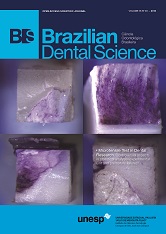Microabrasion Technique for Enamel with Fluorosis: A Case Report Utilizing Two Distinct Pastes
DOI:
https://doi.org/10.14295/bds.2013.v16i3.882Abstract
The technique of enamel microabrasion is considered an aesthetic alternative conservative and effective for stain removal or surface irregularities of the enamel and different materials or pastes can be used for this purpose Objetives: The objective of this study was to compare the efficiency of the technique of enamel microabrasion using two different pastes at removing hypoplastic stains by fluorosis. Methods: The female patient, 18 years, was submitted to enamel microabrasion, and in the right half of the maxilla was manipulated in the proportion of 1:1 by volume a paste of pumice (SSWhite) and 37% phosphoric acid (Etch Alpha, DFL), and in the left half of the maxilla used paste based on hydrochloric acid and 6.6% silicon carbide (Micropol, DMC Equipment Ltd.). In both hemi-arches was performed the same clinical protocol and repeated three times, by the application of 1.0 mm thickness of paste and realized the enamel microabrasion through mechanical friction with rubber cup at low speed for 10 seconds. Then, the teeth were polished with felt disc and diamond paste, and topical fluoride APF 1.23% for 3 minutes was applied. Results: The clinical outcome was similar for both hemi-arches, regardless of the used technique. The success in removing stains on tooth enamel is directly related to a correct diagnosis and accurate indication of microabrasion technique. Conclusions: It can be concluded that the two pastes used in the enamel microabrasion were effective for removing intrinsic stains from fluorosis, with similar results and with the re-establishment of aesthetics of the teeth involved.
Downloads
Downloads
Published
How to Cite
Issue
Section
License
Brazilian Dental Science uses the Creative Commons (CC-BY 4.0) license, thus preserving the integrity of articles in an open access environment. The journal allows the author to retain publishing rights without restrictions.
=================




























